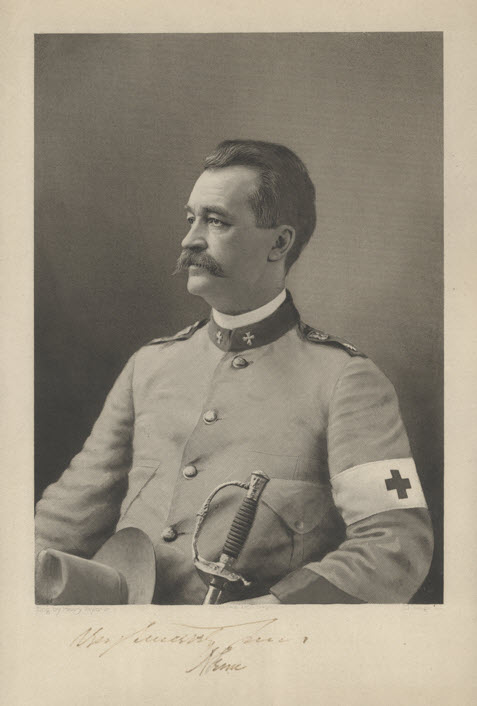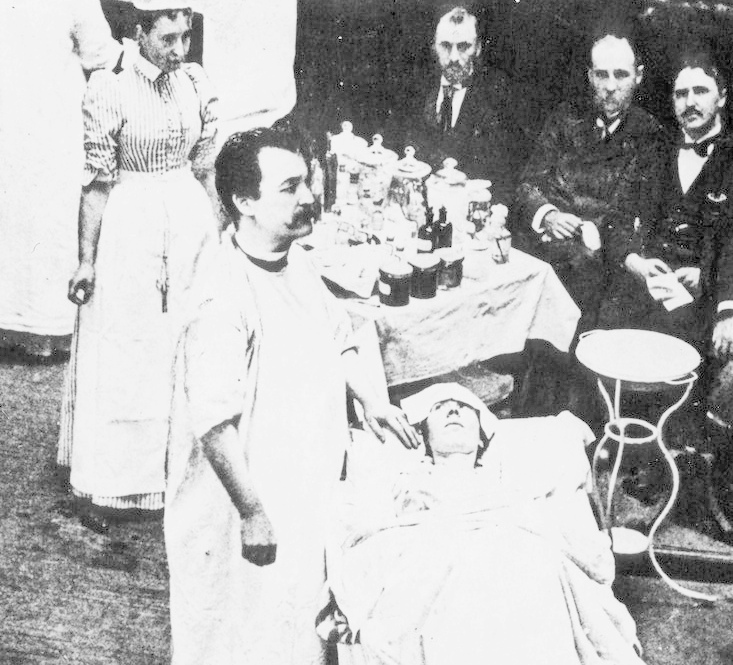Say, you get shot in the stomach. You go to a doctor. The doctor pulls down your pants and starts pumping hydrogen gas up your ass. Then he sets you on fire. Sounds familiar? No? Then you’ve been going to the wrong doctor.
Let me introduce you to Dr. Nicholas Senn, an American surgeon and founder of the Association of Military Surgeons of the United States. He was the president of the American Medical Association in 1897–98 and the chief surgeon of the Sixth Army Corps during the Spanish–American War in 1898.

While serving the war, Senn frequently encountered gunshot wounds in the abdomen in his patients. Lacking proper diagnostic tools (X-rays were just beginning to be used in medicine), Senn and his team of doctors struggled to identify whether the penetrating wound was “simple” or was complicated by injury to the gastrointestinal canal. Injury to the intestines do not present any reliable symptoms upon which surgeons could act to make a positive diagnosis, nor are these visceral wounds evident from an ordinary physical examination.
It occurred to Senn that a wound to the intestines could be detected the same way a plumber locates a leak in a gas pipe. To accomplish this, Senn proposed inflating the intestines with a harmless gas by way of the rectum. If there was a leak, the gas would escape from the intestines into the peritoneal cavity, and from there through the external wound where its presence could be proved by some infallible test. Senn recommended hydrogen gas because it is devoid of toxic properties, is non irritating when brought in contact with living tissues, and is rapidly absorbed by tissues. Besides, the escaping hydrogen gas could be easily detected by putting a match to it. Setting the stomach of a wounded soldier on fire was also an effective way to sterilize the wound, Senn argued.
Related: When ‘Blowing Smoke Up Your Ass’ Was a Real Thing
Nicholas Senn carried out several experiments on dogs first. In these experiments, the animals were strapped on to operating tables, put under anesthesia, and then shot on the abdomen from a short range with a 32 caliber revolver. Immediately after, a hydrogen-gas-filled rubber balloon was attached to the rectum of the animal and gas was slowly pumped into the intestine. When an exposed flame was brought near the wound, the escaping gas ignited with a steady blue flame indicating the bullet had punctured the intestines.
Senn conducted experiments upon a number of his human patients to determine the ill-effects, if any, of introducing gas into the gastrointestinal track. Curious of experiencing the sensation, Senn underwent the experiment himself, having an assistant pump hydrogen gas up his anus. He relates his experience as follow:
Under a pressure of 1/2 pound (.4 kilogram), nearly 6 liters of gas were insufflated per rectum. The distention of the colon caused simply a feeling of distention along its course, but as soon as the gas escaped into the ileum colicky pains were experienced, which increased as insufflation advanced, and only ceased after all the gas had escaped, which was the case only after an hour and a half. When the intestines and the stomach had become fully distended the feeling of distention was distressing, and was attended by a sensation of faintness which caused a profuse clammy perspiration. A great deal of the gas escaped by eructation, which was followed by great relief. The colicky pains attending the inflation of the small intestines by air or gas are evidently caused by increased peristaltic action of the bowels in their attempt to expel their contents, as it always assumed an intermittent type and subsided promptly after the escape of the gas.
Although the first human patient, a 27-years-old black man with a 38 caliber pistol shot wound to his stomach, did not survive, the procedure itself was a success and eventually found use in military surgery to detect bowel wounds in soldiers. Dr. Senn’s methods only became obsolete when X-rays became standard diagnostic tool.
Nicholas Senn was a pioneer in surgical medicine. Aside from his work on gastrointestinal perforation, Doctor Senn was involved in experimental research on acute pancreatitis, plastic surgery, head and neck oncology, and the treatment of leukaemia with x-rays. He strongly supported the early operation for appendicitis, which was not the practice of the time. He also stressed the importance of first aid, first introduced to the military by the German surgeon Friedrich von Esmarch in 1870. Senn frequently quoted the German dictum, “The fate of the wounded rests with the one who applies the first dressing”.

Dr. Nicholas Senn conducting a surgical clinic for medical students in 1895.
References:
# James E. Pilcher, https://www.ncbi.nlm.nih.gov/pmc/articles/PMC1430651/?page=1
# Dale C. Smith, https://academic.oup.com/milmed/article/164/4/243/4832094
# Nicholas Senn, https://jamanetwork.com/journals/jama/article-abstract/436974


